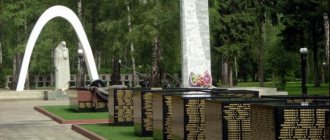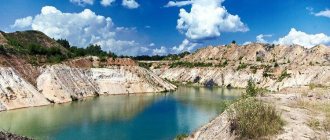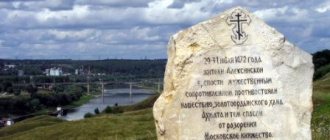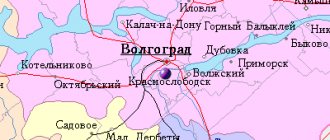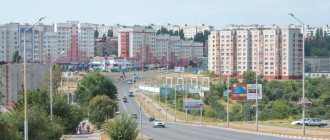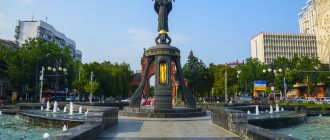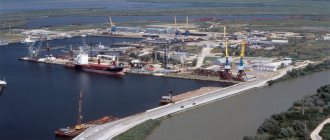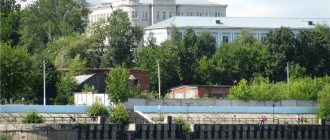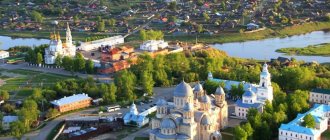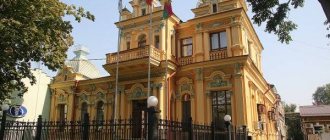Aleksin is a historical pearl of the Tula region, a city with centuries-old history and culture. It was located on the banks of the full-flowing Oka River, starting from the 13th century, it was founded by the Prince of Moscow, Daniil Alexandrovich, and was a trade and defensive point during the years of the Golden Horde dominance. The old part of Aleksin - a distinctive historical center - is very different from the modern buildings on the left bank of the river. The two parts of the town are connected by road bridges. It is one of the historical sites of federal significance, and some of Aleksin’s sights are protected by the state. Let's look at the most interesting places in the city; photos and descriptions of them will also be here, as well as addresses with names.
Interesting natural places
The city of Aleksin is famous for its unique natural sites, which are valued not only among residents of the area, but are also often visited by tourists.
Aleksin Bor
- Coordinates – 54.533500, 37.082687.
This forest is a protected area on the right bank of the Oka. A majestic pine forest spreads over an area of 400 hectares. In a virgin corner of nature, which is under state supervision, there are health boarding houses, tourist recreation centers and a children's camp.
The healing properties of the air, the purity of water sources and the beauty of the area, combined with well-established infrastructure, attract more and more tourists and travelers every year. Mostly, the natural monument is visited for family time, often with even small children.
Holy natural springs
In the city and in nearby settlements, there are three known springs that have healing properties.
- Coordinates – 54.644503, 37.203794.
Not far from the Bobrishchev-Pushkin estate, which is located in the village of Egnyshevka, there is a holy place - the source of the healer Panteleimon. According to legend, several centuries ago a lonely old man settled near a natural miracle. Every day the monk prayed for the believers who came for healing. It was rumored that St. Panteleimon was secretly visited by the imperial family of Nicholas II. After the revolution, the source was destroyed and the hermit was sentenced to execution. A few years later, the spring began to flow with renewed vigor - and to this day its waters heal many diseases.
- Coordinates: 54.541264, 37.090449.
The Zharensky holy spring is a popular place among pilgrims. At the end of the 19th century. was consecrated with the icon of the Smolensk Mother of God. The spring comes out of a rocky cliff and has a unique mineral composition.
- Coordinates – 54.483986, 37.077834.
The source of the healer Euphrosyne, according to legend, was dug by the saint herself. Its healing properties have long been valued by parishioners of the Holy Kazan Church. The area around the spring has been landscaped - a chapel and two baths have been created here.
Bald Mountain
- Coordinates – 54.555939, 37.231158.
An amazing place, beloved by tourists, located on the coast of Vashana, a tributary of the Oka. The hill got its name because of the sparse vegetation and open area, blown from all sides.
Bald Mountain is also famous for its archaeological finds. Local historians discovered caves that date back to the Paleolithic era.
At the top of the natural site, festivals are held and tourist meetings are organized. There is an opinion among regulars that the hill has magic, and scientists have proven more than once that Bald Mountain is a geopathogenic zone.
Petrovsky Park
- Coordinates – 54.481595, 36.989975.
This square is located near the Palace of Culture named after. A.P. Chekhov. On its territory there is an Obelisk for returning fellow countrymen. Guests of Petrovsky Park note that it is very quiet and peaceful, you can easily walk with a stroller and older children. There are also swings, although most of them are rusty. And many people recommend walking here before dusk, since in the evening you can hardly see anything - the lighting is very poor.
Geographical location of Aleksinsky district on the map
Aleksinsky district on the map is located in the northwestern part of the Tula region on the territory of the Central Russian Upland.
In total it occupies 982.5 sq. km. It borders on the lands of the Kaluga region, Zaoksky, Yasnogorsky, Dubensky and Leninsky districts. In 2014, Aleksinsky district was transformed into a city district. The official name is “municipal formation of the city of Aleksin.” The area is distinguished by a favorable geographical location: Moscow is located 150 km to the south, and Tula and Kaluga are 60 km away. The administrative center is the city of Aleksin . In addition to it, there are another 155 settlements on the territory. The population is just over 70,000 people, with more than 85% living in the city of Aleksin and in the Novogurovsky workers' village.
On the map of the Aleksinsky district, which belongs to the Volga-Oka basin, 5 large rivers are marked - Oka, Krushma, Myshega, Vashana, Svinka. Fresh, coastal, low-mineralized springs also flow here. There are several dozen lakes and ponds. A quarter of the land is occupied by pine forests and massive broad-leaved trees. On the high right bank of the Oka, in the western sector, lies the relict Aleksin-Bor - a natural monument, a protected protected area.
The terrain is hilly. There are deposits of brown coal, refractory clay, sand, gravel, marbled limestone, gypsum, rock salt, quartz and construction sands.
Aleksin and its museums, cultural centers
Aleksinsky Museum of Art and Local Lore
- Address: Sovetskaya, 38.
The museum is located in the city center, in the former house of merchant A.M. Maslov, built in the 18th century. The first exhibitions opened to visitors in 1980 and were replenished with hundreds of exhibits every year.
The Aleksinsky Museum has a wealth of materials on the history, art, geology and ethnography of the city, which are housed in 13 main and several interchangeable exhibition halls. The topics of the exhibitions are varied.
In the nature department of the Aleksinsky region you can learn about the flora and fauna of the local lands. The historical part of the attraction will tell about the life of the Vyatichi tribe who inhabited the lands on the Oka coast, about the merchant way of life through interior exhibitions. The postal history section is one for the entire museum system of the Tula region, where a large collection of postal supplies is collected, something like this cannot be found even in Tula .
The museum constantly opens art exhibitions and organizes literary and theatrical evenings.
House of Culture named after Chekhov
- Address – Metallistov, 4.
Museum exhibitions are often held at the Anton Pavlovich Chekhov House of Culture in the Petrovsky microdistrict. Here, theatrical performances are organized for guests, various children's clubs operate, and discos are organized for young people.
The building of the cultural center is very beautiful - it stands out against the backdrop of urban development. The color of the facade is light green. It itself is decorated with four whitewashed columns and a balcony. It’s also cozy inside, the chairs are comfortable, and the stage is clearly visible from any row.
On topic - TOP attractions of the Tula region
Top 10 attractions of Aleksin
It is difficult to see all the sights in Aleksin in 1 day. Therefore, for future tourists, I have compiled a list of the most interesting places that I definitely recommend visiting.
Church of the Transfiguration of the Lord
The village of Spas-Konino is located 15 kilometers from the city of Aleksin.
Erected in 1860 in the village of Spaso-Konino with donations from parishioners and funds allocated by the landowner Frolov.
The Church of the Transfiguration of the Lord is located on a hill surrounded by trees. The snow-white facades of the church go well with the domes and blue roofing. The bell tower is decorated in the same style. At the main entrance, the porch is paved with multi-colored tiles.
Previously, at this place at different times there were 3 wooden temples, 2 of which burned down, and 1 was destroyed.
Lenin monument
The monument to V.I. Lenin is located in the center of the city market square.
The monument to the leader of the revolution was erected in 1969; Egorov is considered the sculptor. The monument is included in the historical and cultural list of objects of regional significance.
On a high green pedestal, Lenin stands at full height, with his hand raised high and in a cloak. Surrounded by fir trees and other trees, the leader seems to be addressing the people. Next to the monument there are flower beds; the monument itself is located in a green meadow.
Church of the Resurrection
The village of Bogucharovo is located 10 kilometers from the city of Aleksin.
Erected in 1803 with funds donated by the landowner I. Polibin. The temple is located at the highest point of the village of Bogucharovo, from here there are beautiful views of the surrounding area, forests and mountains are clearly visible. Previously, there was a wooden chapel on the site of the church.
You will also like: What a tourist should definitely see in Adygea
Now the temple is in a dilapidated state, immediately behind it there is an abandoned ancient cemetery.
However, you can see the remains of the building and walk around inside the church. In some places, artistic paintings can be seen on the walls of the temple, and there are tiles on the floor. Windows and doors are missing or in dilapidated condition.
Aleksin-bor
Aleksin-bor is located on the banks of the Oka River; on the territory you can find a beautiful lake and spring.
The protected area is located on the right bank of the Oka River and covers an area of 400 hectares. Pines grow here predominantly, although other trees are also found.
Thanks to the fresh air, crystal clear water from forest springs and the absence of pollution, boarding houses, tourist complexes and a camp for children have been built in the forest. Not only school students, but also adults, both locals and tourists, regularly come here to improve their health.
Museum of Art and Local Lore
The Art and Local History Museum is located in the historical part of the city.
The exhibition is located in the very center of Aleksin in a house that formerly belonged to the merchant A.M. Maslov. For the first time, visitors were able to see the museum’s collections in 1980. Among the exhibits are works of art, historical documents, and geological finds. In total, the museum has 13 main and several additional rooms intended for holding art exhibitions, literary and theatrical evenings.
In the Nature Hall you can get acquainted with the peculiarities of the local flora and fauna. In the historical room, visitors will learn about the life of the Vyatichi people and merchant life. Also, the Aleksinsky Museum houses one of the largest collections of postal supplies.
Giant chair
A huge chair acts as a canopy in front of the entrance.
In Aleksin there is a small furniture store located in a 2-story building. The facades of the building have not been renovated for a long time, but the canopy over the main entrance is considered a local landmark. It is made in the form of a large chair, the wooden parts of which are painted brown. This is one of the favorite places where visitors like to take pictures.
House of Maslovs
The mansion is a significant monument of urban architecture of the 18th century.
The mansion was built in the 18th century. and is considered one of the largest buildings in the Tula region. The facades of the house are painted in white and yellow shades, the roof is made of metal. The main part of the mansion, consisting of 3 floors, has massive columns. Many of the house's windows are decorated with arched stucco.
The architectural ensemble of the estate consists of the main estate and outbuildings attached to it. Now the building houses a local history museum and a regional house of culture. The mansion is included in the list of objects protected by the state.
You'll also like: Best attractions in Baltiysk
Bald Mountain
Some people who have visited the bald mountain near Aleksin talk about strange flying objects in the area.
It is located next to a tributary of the Oka - the Vashana River. The place was called “Bald Mountain” not because of the presence of witches, but because of its location in an open area, blown from all sides by winds. In addition, there is little vegetation here.
Bald Mountain is also famous for its archaeological finds. During excavations, scientists discovered caves dating back to the Paleolithic era. Festivals are often organized at the summit. Local residents believe that the mountain is magical, and scientists have proven that the hill is a geopathogenic zone.
Holy Kazan Convent
The monastery was founded in 1995 by decree of Patriarch of Moscow and All Rus' Alexy II.
Located in the village of Kolyupanovo. According to legend, Catherine II's maid of honor, Euphrosyne, escaped from the palace and took refuge in this area. The girl was famous for her gift of healing people, and subsequently dug a well with her own hands, the water from which is considered healing even now. In memory of Saint Euphrosyne, a monastery was built and a marble slab was installed.
Manor's house
The Manor House in Aleksin is included in the list of attractions of the Central region of Russia.
Erected in 1773 in the classicism style. It was a 2-story brick house, to which utility rooms were attached.
Now the mansion is in a ruined state, you can only examine the ruins. There is a park next to the house.
Temples and churches of Aleksin
Aleksin's temple architecture combined the features of ancient Russian temple architecture and modern church buildings. The abundance of holy places has made the city a real pilgrimage center.
New and Old Dormition churches
- Address - pl. Sobornaya, 1.
On the hill of the Cathedral Hill there are ancient examples of Aleksin's church architecture - the old and new Cathedral Churches of the Dormition of the Mother of God.
The construction of the old cathedral was erected at the end of the 17th century at the expense of local boyars and became the first stone building in Aleksin. At the beginning of the 19th century, Aleksin merchant I.A. Maslov provided financial assistance during the construction of the new temple. Both parishes embodied the restrained harmony of the proportions of church architecture.
It is noteworthy that after the opening of the new Assumption Church, the future Russian autocrat Alexander II visited it. That is why, before the revolutionary years, imperial crowns adorned the crosses of cathedrals.
In 1917, the churches were first closed, and then began to be used for economic needs. The buildings fell into disrepair and were on the verge of disappearing. In 2005, the old cathedral was included in the federal program for the restoration of architectural monuments. The restorers carefully tried to replicate the old masonry to ensure the integrity of the image. In 2013, the church building was re-illuminated.
In the new Assumption Church, restoration work began in 2015. At the moment, the 3-tier bell tower, built in 1829 not far from the Orthodox shrine, is being restored.
Holy Kazan Convent
- Address: Kolyupanovo village.
In the village of Kolyupanovo, Aleksinsky district in the 1990s. By the most holy decree of the Patriarch of Moscow, a monastic monastery was erected. The site of the founding of the convent is the land where the temple of the icon of the Mother of God previously existed, dating back to the 17th century. Particularly revered by local nuns is St. Efrosinia Kolyupanovskaya.
According to historical sources, the girl was one of Catherine II's ladies-in-waiting. She renounced the pomp of social life and secretly fled, wanting to hide from the world. Mother spent her entire life traveling, healing people. Having settled in the village. Klyupanovo dug a well with her own hands, the waters of which are still considered miraculous. In memory of the blessed old woman, a marble slab was installed on the territory of the monastery.
Today, next to the Holy Kazan temple complex, the Church of the Holy Trinity was built along with two indoor baths. Every year crowds of believers come to Aleksin to venerate the tomb of St. Euphrosyne and to feel the wonderful properties of the holy spring.
Tsarevich-Alexievsky Church
- Coordinates – 54.526094, 37.070883.
Among the pines of the Aleksinsky Forest, you can barely notice a small church building, which was erected by parishioners in 2006. There was once a Soviet children's camp here, but since the 2000s. These lands were transferred to the possession of the Tula diocese. The temple is dedicated to the great martyrs of the royal family and is an example of Russian wooden architecture.
St. Nicholas Cathedral
- Address: Sovetskaya, 43.
At the end of the 18th century, this beautiful cathedral was erected with donations from the Savostin brothers, Aleksin merchants. The architectural monument was founded in honor of St. Nicholas the Wonderworker, whose image occupies a special place on the carved iconostasis.
The combination of baroque and classicism features gave the building majestic elegance. The appearance is striking: a snow-white facade, a magnificent row of columns, and the undoubted difference between this parish and others in Aleksin is the sonorous 2-tier bell tower.
During the Great Patriotic War, a bomb fell on the church building and almost destroyed the architectural masterpiece. Since the late 1990s. restoration work is underway here. A parish school is open for the youngest parishioners.
Aleksin
According to legend, Aleksin was founded at the end of the 13th century. The founder was Daniil Alexandrovich Moskovsky, the son of Alexander Nevsky. The legend says that the prince toured his possessions during his stay in Moscow. When Daniel reached the place where modern Aleksin is located, he received the good news of the birth of his son Alexei. In order to somehow mark the joyful event, the prince ordered the foundation of a city in the place where he received the news, and to name it in honor of his son. To date, no evidence has been found that the above story is accurate. The official starting point for the existence of the city was 1348. The first mentions of Aleksin date back to this year. The Nikon Chronicle says that in 1348, Prince Temir of Orda approached “the city of Oleksin” with his army, after which he returned to the Horde. Since 1325, Aleksin was in the possession of the Moscow metropolitans, then passed to the grand ducal house. From 1354 to 1378, Aleksin belonged to the head of the Russian Orthodox Church, Metropolitan Alexy. It is assumed that the city got its name from him. The question of the exact date of foundation of the city and its original location still remains open.
Since its foundation, the history of Aleksin has been inextricably linked with the struggle of its inhabitants against foreign invaders. The Aleksinites had to fight against Horde rule. Residents of the city repeatedly fought with the Principality of Lithuania, which laid claim to Aleksin. At least ten times the city was completely destroyed by foreigners, but each time the city residents managed to revive Aleksin. In addition, the city was destroyed by numerous natural disasters. The population of Aleksin has repeatedly declined due to epidemics. The city was located, unlike other cities on the Oka, on the right bank. The right bank was considered “enemy”, that is, convenient for attack by potential invaders. One of the chronicles talks about how in 1472 Khan Akhmat went to Moscow, and on the way attacked the fortress city of Aleksin. The inhabitants of the fortress desperately resisted. Within 24 hours Akhmat tried to take the city. However, his attempts were never successful, and the khan decided to set fire to Aleksin. City residents continued to fight back. During this time, help arrived from Moscow. No more than five hundred people lived in the fortress. However, the Aleksinians did not surrender to the larger enemy and did not allow him into the fortress. The merit of the city residents also lay in the fact that they significantly undermined the enemy’s forces and did not give him the opportunity to approach Moscow. Since then, the Moscow government has paid significant attention to strengthening the city. Without exaggeration, we can say that the failure that Khan Akhmat suffered under Alexin marked the beginning of the overthrow of the Tatar-Mongol yoke in Rus'. It was after this campaign that Moscow stopped paying tribute to the invaders. The Moscow government received confirmation that the Tatar-Mongols were far from being as invincible as previously thought. For the first time, Russia is beginning to position itself as a sovereign, independent state.
At the end of the 16th century, Aleksin was the location of the second most important army of the Grand Duke. This may indicate that the city was considered by the Moscow government as an important strategic site. In 1566, Aleksin was visited by Ivan the Terrible. He issued a decree to include the city in his personal possessions.
The events of the Time of Troubles did not bypass Aleksin. Residents of the city recognized Tsarevich Dmitry in False Dmitry I and went over to his side. But after some time, the Aleksinites already swore allegiance to Vasily Shuisky. Residents of the city also supported Ivan Bolotnikov, who was marching on Moscow. The Aleksinians paid very dearly for their new “addiction”. On June 29, 1607, the city was captured by a punitive detachment and almost completely destroyed. Aleksin was restored only in 1642. A new wooden fort was built on the site of the previous fortress. Unfortunately, the new fortress turned out to be short-lived and fragile. In 1665, the fort had to be replaced by a “cut” city. With the accession of Peter I to the throne, Aleksin, among other cities, was assigned to the Moscow province.
In the 17th-18th centuries the city gradually lost its defensive significance. Aleksin becomes a trade and craft settlement. Successful trade is facilitated by the convenient location of the city on the Oka River. Goods manufactured in Aleksin could be easily shipped to other cities. It was also very convenient to import goods to Aleksin. A new stage in the history of Aleksin began with the construction of an ironworks on the Myshega River, the founders of which in 1728 were Tula natives Maxim Masolov and his brothers. A year after construction was completed, the plant produced its first cast iron melt. At the beginning of the 19th century, the Myshega plant became known throughout Russia. Figure casting brought fame to the company.
For centuries, there was a fishing settlement in Aleksin. Oka has always been rich in fish. Local fishermen, although they were not wealthy, never went hungry. In the 16th century, they received a special privilege: supplying fish to the royal table. In this way, the fishermen paid the tax. In memory of the fact that fishing flourished in the city, one of the streets of modern Aleksin is called Rybnaya.
Aleksin's unique architecture was severely damaged during a fire in 1768. The streets of the city were narrow, the houses were covered with brushwood and straw. All this contributed to the lightning spread of the fire. The old Russian layout of the city has completely disappeared. The old layout was replaced by a regular grid of blocks. A new construction plan was approved in 1769. The redevelopment of Aleksin was associated with special difficulties associated with the fact that most of the city's population was engaged in arable farming. A special plot of land was allocated on the outskirts of Aleksin. Aleksin merchants settled in the central quarters. The families of the Maslovs, Zolotarevs, Rykalovs and Azimovs were considered the most prosperous in the city. Thanks to these families, a huge number of new stone buildings were built in Aleksin. Despite the fact that the buildings were made of stone, most of them have not survived. The most luxurious stone building in the city was the house of Mrs. Maslova, located opposite the St. Nicholas Church. The house occupied so much space that it seemed to the residents of the city an entire estate. Such luxury could not always be found even in Moscow and St. Petersburg. The builder of the house was not a nobleman, but an ordinary merchant of the second guild, Ivan Maslov, who owned a large linen factory. The merchants in Aleksin sought to imitate the noble class of large cities in everything, building luxurious houses in Aleksin itself and huge estates outside the city.
In the “List of Populated Places of the Tula Province” for 1859, Aleksin is listed as a district town of the Aleksinsky district on the Oka River, 52.5 versts from the provincial city of Tula. The city had 281 houses and 3,101 residents of both sexes - 1,580 males and 1,521 females. Indicated: 5 Orthodox churches, a district school, an almshouse, a hospital, a postal station, a pier, 8 factories.
At the beginning of the 19th century, the city experienced economic decline. The Maslov linen factory closed, leaving the Aleksin residents who worked there without a livelihood. It seemed that the city was gradually dying, reviving only on the days of fairs held twice a year. Changes in the life of the city came only in the 70s of the 19th century, when a railway was built through Aleksin. Kaluga and Tula summer residents began to come to the city. Aleksinsky pine forest was very popular among vacationers. At the beginning of the twentieth century, this forest became a resort place. By 1915, more than seventy dachas had been built here, many of which have survived in the forest to this day.
According to the “First General Population Census” for 1897, the population of the district town of Aleksin was 3,465 people - 1,734 males and 1,731 females. According to this indicator, the city occupied the penultimate 11th place in the province among all cities. By estate, the total population included: hereditary nobles - 227, clergy - 54, merchants - 63, burghers - 1,392, peasants - 1,638, foreign subjects - 5, other estates - 86.
In 1917, a change in the political system occurred in the country, and Aleksin’s life began to change. In 1924, the city became the administrative center of the Aleksinsky district (since 1937 the district belongs to the Tula region). In 1933, the government decided to build a chemical plant in the Moscow region, which in those years included the city of Aleksin. At the end of March 1941, the thermal power plant was put into operation.
During the Great Patriotic War, the city and region were occupied by the Nazis. The occupation lasted from late October to mid-December 1941. The Nazis robbed most of the population of the area, destroyed about a hundred agricultural buildings, and burned more than a dozen villages. Most industrial enterprises in the region and city ceased their activities due to the occupation. Just like several centuries ago, the city again closed Moscow off from the enemy. The battle for Aleksin lasted three days. On the first day, the Nazis offered fierce resistance. Settlements in the Aleksinsky district repeatedly changed hands. On the second day, the forces of the invaders increased somewhat due to the reserve forces that came to the rescue. It was possible to cope with the enemy only on the third day.
In 1958, Aleksin, located on the right bank of the Oka, was merged with the workers' settlements located on the left bank. The area between the villages and the city was not built up. The workers' settlements annexed to the city were called Vysoky, Myshega, Petrovka and Sotsgorod. Today they are considered districts of Aleksin. The names of the villages became the names of districts. Most of the houses in these areas are barracks type. The buildings were built for workers in the 1930s and 1940s. Residents of the area joke that horror films can be filmed here even without decorations. It seems that the filmmakers have listened to this opinion. In 1964, the comedy “Welcome, or No Entry to Outsiders” was filmed near Aleksin. Filming took place in the pioneer camp "Zapolyarye". In the second half of the 60s, a bridge across the Oka was opened. The bridge was in disrepair for many years.
Aleksin's economic rise began only in the 70s. Coal mining began not far from the city. “Microdistrict No. 2 – Shakhtyorsky” was built next to the mine, which consisted of several houses in which miners and their families were supposed to live. However, coal mining soon had to be abandoned. The mining itself was much more expensive than coal.
Guests of the city note with admiration that the houses in the new quarters and microdistricts of Aleksin are significantly different from new buildings in other cities. The Bor microdistrict appeared in 1967. The microdistrict is famous for the fact that it was here that the first (and currently only) wide-screen cinema “Soyuz” appeared. One of the first enterprises of the city, an ironworks, built back in 1728, is today located in Myshega. Aleksinsky Chemical Plant is located in Vysokoye. Petrovka is considered the most remote area. It is located a few kilometers from Sotsgorod. The main enterprise of Petrovka is the Aleksinsky Experimental Mechanical Plant. The area is so remote that for many years there was even a church there. On the road to Petrovka you can see the small village of Energetik. The population of this village works mainly at the local thermal power plant. Not far from the village, the Aleksinskaya educational colony was built. The prison was founded in 1936 as a general regime colony. During the war, there was a camp for captured soldiers here. The colony became a children's prison in 1956.
Modern Aleksin can rightfully be considered one of the most dynamically developing municipalities in the Tula region. Today, more than a dozen of the largest enterprises operate in the city, providing stable income to hundreds of thousands of people. Small and medium-sized businesses are successfully developing in Aleksin, and the transport infrastructure is functioning. Invaluable cultural and historical monuments of the city, health resorts are known far beyond Aleksin. At the beginning of January 2011, the bridge over the Oka was repaired. The city now has 2 bridge spans along which cars move. At the beginning of the new millennium, 2 new enterprises were built in the city. In 2012, restoration work was carried out at the Aleksin chemical plant aimed at updating production. In mid-2012, for the first time in the history of Aleksin, a woman, Lyubov Galkina, became the head of the municipal formation of Aleksinsky District.
Architectural landmarks
The city of Aleksin boasts interesting architectural sites. The remains of manorial estates of the 18th-19th centuries located along the banks of the Oka River are still breathtaking.
House of Berov
- Address: Petrovsky microdistrict.
An interesting place in Aleksin is a dilapidated 2-story building of the 18th century, which received the popular name “manor’s house”. The ancient estate is located on the high coast of the Oka River and was once the center of social life in the city.
The history of the architectural complex begins in the late 1770s, when these lands were inherited by a noble nobleman and close associate of Catherine’s court, Ivan Petrovich Tyufyakin. The picturesque landscapes and amazing views of the river did not go unnoticed by the nobles.
In 1773, construction began on a majestic manor complex in the classicist style. The central façade of the manor house had a semicircular projection with a spectacular Doric colonnade. Above it was a terrace with an excellent view of the surrounding area. Inside there were state rooms and halls with stucco moldings and tiled tiles. The house was surrounded by a garden and park area.
The last owners of this architectural landmark of Aleksin were the family of the famous official V.V. Bera. The new owner's hobbies were art and literature. The guests of the estate were Chekhov, Scriabin, Pasternak, who stayed in the attached outbuildings.
Despite the fact that the architectural creation is dilapidated these days, there are no fewer people wanting to admire the noble residence.
Kolosovsky Castle
- Address – village. Kolosovo.
On the outskirts of Aleksin there is a “Gothic miracle” - an architectural structure of the 19th century. The estate was founded by the nobleman Dmitry Aleksandrovich Chertkov on the banks of the Oka.
From the main road, guests turned into a linden alley that led to a large carved gate. The snow-white main house, decorated with columns and massive windows, was located in the center of the ceremonial avenue-park.
The appearance of the building and the entire estate was decorated in a “foreign” manner. Initially, the architectural structure was built in the Empire style, but at the end of the century, the new owner, K.N. Paskhalov, transforms the Chertkovsky house into a Gothic castle.
Vaulted arches and the main tower with an open area added mystery to the estate. A marble staircase with a fountain complex was erected on the adjacent territory. There is a huge winter garden inside - a special pride of the owners.
On the estate, on one of the outbuildings, a wooden clock tower was built. The chapel was clearly visible from the windows of the Kolosovsky Castle. The building with the dial remains today. The estate in Kolosovo attracts tourists with its legend about the underground passage. Going down to the Oka River along a dilapidated staircase, you can find the arched vault of the exit from the underground tunnel.
Now the architectural complex is in disrepair. The interior was destroyed by fires, and the exterior conveys only part of the former beauty of the Gothic castle.
Ryurikovo station
- Address: Ryurikovo village.
At the end of the 19th century. in the village of Pershino there was an estate owned by the uncle of Emperor Nicholas II - Grand Duke Nikolai Nikolaevich. Thanks to his diligence, the village thundered not only throughout Russia. Even in European secular circles there was talk about the prince’s exemplary dog hunts.
Not far from the estate, on the orders of a member of the royal family, Moscow architects worked on the construction of a railway station. The spectacular structure amazed the eminent guests, who were then impressed and did not notice the shortcomings of the tedious path to Pershino. The Ryurikovo station was built in pseudo-Russian style. The building resembled a tower with a main entrance and a patterned facade. According to historical sources, there was once even a station church here.
This architectural masterpiece is deteriorating and collapsing these days. The station building is not in use today.
Historical monuments and memorials
Residents of Aleksin honor the memory of heroes and figures who glorified their native land, because the exploits of their ancestors are immortal, and their names are immortalized for the future descendants of the city.
Memorial Mound of Glory
- Coordinates – 54.519942, 37.232805.
During the Great Patriotic War, the front line was located on the territory of Aleksin, which was heroically defended by the 238th Infantry Division G.P. Korotkova. In the middle of the 20th century. On the site of the heroic confrontation, a memorial complex was erected - the Mound of Glory.
In the center there are stand plates with the names of the defenders and the Eternal Flame is constantly burning. Nearby there is a monument to the Unknown Soldier and a small area where an artillery gun flaunts on a pedestal. The pine plantations around the memorial give the place an atmosphere of eternal tranquility.
Memorial complex in memory of the events of 1472
- Address: Ratnaya Glory Square.
1472 became a turning point in the history of not only the Aleksin fortress, but also all of Moscow Rus' as a whole. The Khanate of the Golden Horde did not stop trying to subjugate the Russian lands.
The military garrison of the Alexin Fortress, at the cost of its existence, blocked the possible advance of the Golden Horde army deep into Rus'. Khan Akhmat did not expect to receive resistance from a small defensive point and turned his hordes back. Scientists believe that this event could have become the breaking point of liberation from the rule of the Horde.
In memory of the heroism of ancient Russian warriors, a historical memorial was opened in 2001 on the central street of the city. The central place is occupied by a stele, surrounded by massive slabs with images of military operations.
General information about the city
Aleksin is located in the Tula region on the banks of the Oka River. The settlement was founded in the 13th century. Prince Daniil Alexandrovich as a trading settlement and at the same time a defensive fortress to protect the borders from the troops of the Golden Horde.
The territory of Aleksin is divided into 2 parts by a river, across which several bridges were built. In the Old Town (Zarechye) there are mainly ancient buildings, including:
- restored churches;
- former merchant houses;
- dilapidated and preserved estates.
On the other bank there are areas built up during the USSR, as well as modern buildings.
Amazing places of Aleksin
Giant chair
- Address: Tulskaya, 5.
Tourists in Aleksin have long noticed the object of a marketing ploy for one of the city’s furniture stores, which is located on Tulskaya Street. The gigantic chair serves as a kind of canopy over the entrance. Taking a photo with the wonder is not prohibited by the owners of the local emergency.
DOL "Zapolyarye" - the location of the filming of the famous Soviet film
- Address: Aleksin Bor Nature Reserve.
It was in the Aleksin camp that the filming of the film “Welcome, or No Trespassing” took place in 1963. The camp complex still functions today, but all buildings have been rebuilt. The only thing left is a beautiful view of the river.
Entertainment for children in Aleksin
If an excursion to Aleksin is planned as a family trip, then you should visit places intended for family leisure and entertainment.
Zoo farm "Alexin-ostrich"
- Coordinates – 54.517723, 37.241116.
In the vicinity of Aleksin, over a large area, there is a private zoo farm. Ostriches of various breeds are mainly raised here. But besides these representatives of the fauna, children will be interested in meeting some species of artiodactyls and predators. On the farm you can observe the habits of animals, and you can even feed and pet the herbivores. A visit to this attraction will give your family vacation new colors and emotions.
MBU Cultural and leisure center of the city of Aleksin
- Address – Mira, 19.
As reviews online say, this is one of the few places in Aleksin where you can spend your leisure time fun and usefully. The building of the Cultural and Leisure Center is not new - it was built during the USSR period, but at the same time, everything here is maintained in proper condition. Aleksin residents speak very positively about this place, saying that local firms and companies often organize events here. And even though it’s rare, TV stars still come here. There are also circus performances that children of all ages love to watch. There is a fountain near the center, and a memorial sign “Letter to Descendants 1917-2017” is also found.
Khimik Stadium
- Address: Mira Street.
Children, especially teenagers, will simply be delighted to visit this sports complex. For visitors, there are grounds for sports such as football, mini-football and volleyball. There is also a place where those interested can play basketball and badminton. You can work out in the Gym, prices are low.
Don't miss guides to other cities of the Tula region - Veneva, Beleva and Bogoroditsk
As you can see, Aleksin is completely imbued with Russian identity and culture. Its historical district will be a gift for connoisseurs of antiquities, and new developments will delight with expanded infrastructure. In Aleksin, every tourist will find something to see and where to go - whether they come for one day or for a long weekend.
